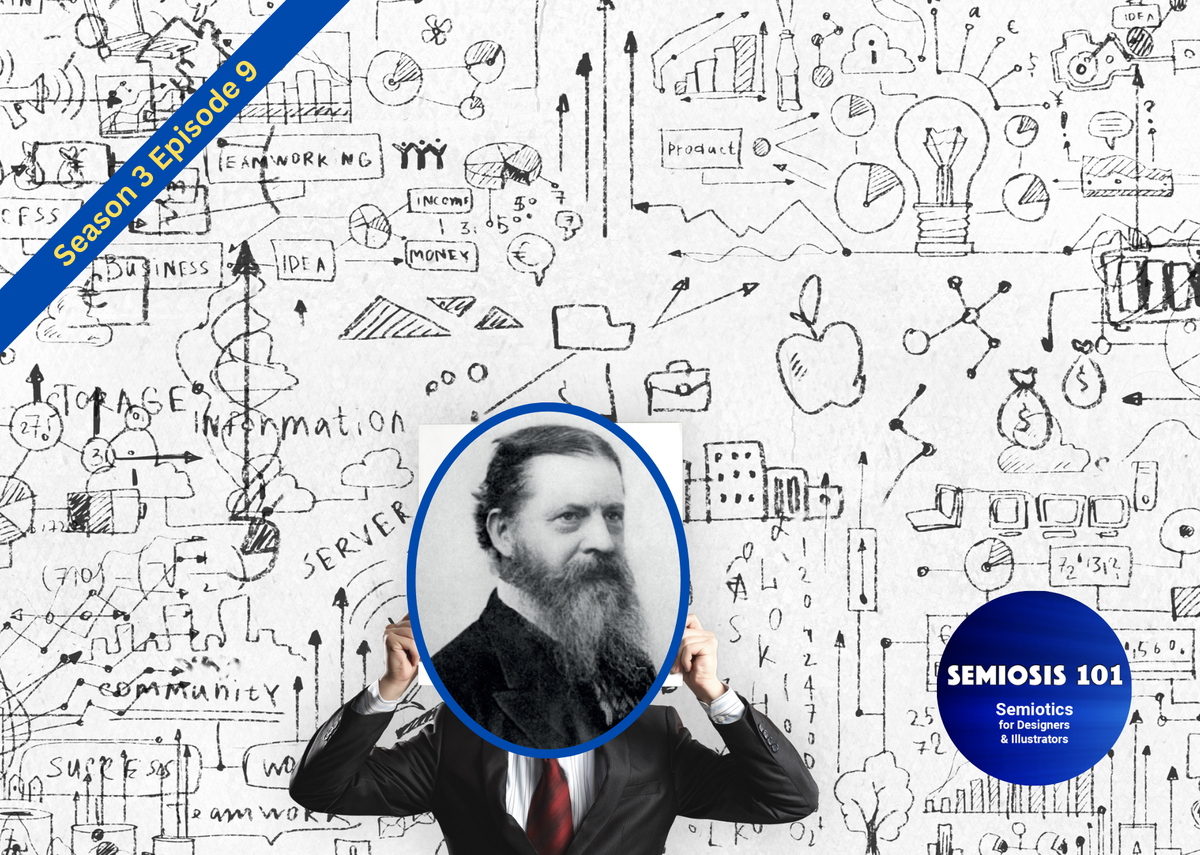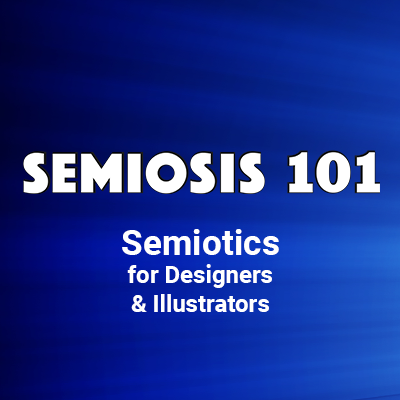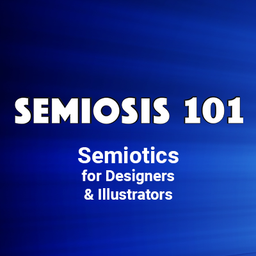Free Semiosis 101 Transcript 3.9:

YOUR FIRST SEMIOTIC IDEA: Enhancing Your Ideation One Semiotic Sign at a Time!
Hello readers.
In this free transcript for the episode published on Semiosis 101 on 27th December 2023, we discuss applying semiotic sign-action. It is predicated on the visual form the representation of a concept takes, how the semiotic representation is interpreted AND how the representation conveys its meaning to be interpreted.
Watch the free episode on YouTube for the full impact…
…and here is the episode’s transcript.
In applying Semiosis, its semiotic sign-action is not predicated on the visual form the representation of a concept takes (Peirce’s terms are Iconic, Indexical and Symbolic) but also on two other points. How the semiotic representation is interpreted (Peirce’s terms are Rheme, Dicent and Argument) AND how the representation conveys its meaning to be interpreted (Peirce’s terms are Qualisign, Sinsign and Legisign).
But what does any of this mean? Hit subscribe to this YouTube channel, and I will explain…
In the context of visual communication, will it take too long to bother encoding semiotic signs?
After all, none of those terms mean anything to creatives. The answer to the question is NO as it is just now mindfully tweaking what creatives already do during ideation and sketching. But creatives have a point with the terminology. The terms are obtuse, and …semioticians you know what is coming… off-putting to creative people.
Over two seasons of Semiosis 101 we have covered Iconic, Indexical and Symbolic representation. Each new Semiosis 101 episode brings in new viewers so these terms will always be obtuse. Now in season three I am dropping three further terms into play:
Rheme, Dicent and Argument; and Qualisign, Sinsign and Legisign.
Whatever are we to do about explaining these terms? Do not press STOP! Do not panic! We will now contextualise these semiotic terms into your creative practice. Just like during your ideation there are things that are unknown, and then known and provide you with insights to successfully answer a brief, these terms are just like that. Nothing more. The ideas behind Peirce’s obtuse terminology are what will be insightful. Trust me.
So, to first recap on what viewers of Semiosis 101 already know from two seasons of episodes… Iconic, Indexical and Symbolic representation are the three levels of how a concept (meaning) can be semiotically represented. Rheme, Dicent and Argument are the levels of how interpretation is made from the semiotic representation. Qualisign, Sinsign and Legisign are the levels that the form the semiotic sign takes to communicate. I am still sensing incredulity out there. Let me put this in designer-centric terms.
When you sketch a possible idea, what are you doing? You are trying to visually represent an idea you just thought of. As I say to my students, who are reticent at ideation and want to rush to the MAC and Adobe to DO DESIGN with their first idea… first show me.
Let us summarise. A creative gets an idea to answer the brief. That idea is floating around the synapses of their brain. The idea is genius. But how to visualise it? The creative makes a mark, a line, a shape, a colour. This begins to crudely resemble the qualities in the idea. This is sketched quickly on paper and is shown to another person.
Remember, the creative has total belief their idea now on paper is genius. Surely everyone will see from a few lines their genius?
The second person looks at the crude lines scrawled on the paper, representing the idea that the creative believes to be genius, and says “I do not get it?”
Is the idea not genius? At this stage it is too early to say. Is the sketching poor? It is a sketch, so maybe, or maybe not. Is the second person an idiot? Absolutely not.
So where does the communication problem lie? Let me quickly append some of Peirce’s lowest level terms to this scenario before we move on to resolving this. The creative makes a mark, a line, a shape, a colour. Iconic representation. This begins to crudely resemble the qualities in the idea. Rhematic. This is sketched quickly on paper and is shown to another person. Qualisign.
Let us unpack this…The crude sketch is comprised of individual marks (lines, shapes, colours, etc). Once these are perceived as something meaning-bearing they begin to work semiotically. Sign-action has been triggered by the act of perception of someone else. As the creative, you know those marks do bear meaning (otherwise you would not have bothered). You have used Iconic representation to try to encode meaning in a few crude lines. These lines suggest familiarity to qualities and resemblances of what defines the idea in your head.
The second person cannot open your head and look into what you are thinking. So is reliant on the sketch and its Iconic representation to try to understand. They see the sketched lines and these crude patterns suggest a probable interpretation based on THEIR own lived experiences, and not the lived experience of the creative. The second person sees the sketch, tries to interpret something from it based on the possibility of something they may have encountered before (Rhematic). They, in this scenario, then say “I do not get it!” They see the lines suggests some basic meaning (Iconic), they have tried to find that basic meaning (Rhematic), but how it has been presented is a sticking point in a successful interpretation.
A Qualisign, Sinsign and Legisign are the levels of visual agency, to ensure the meaning-bearing elements are perceived and successfully interpreted. (Admit it, you thought I was going to say that the paper was the Qualisign!) A Qualisign is Peirce’s term to describe the lowest level of visual agency that is nothing more than visual qualities.
What I have just described above is Peirce’s lowest classification that a semitic sign can take. An idea that is sketched with basic levels of meaning. That are only represented as possible visual qualities to something that someone may find familiar. This is Sign One in Peirce’s ten sign classifications. (More on these next month). A first sketch to show what you mean is obviously something that is a first draft. It needs further refinement. This is how Semiosis at the lowest level of visual representation begins to work.
You have all done this scenario, and heard “I do not get it!” You do not give up. You refine, you re-sketch and you improve its visual communication. Every time you re-sketch or select something else to communicate what you mean, you are crafting your Iconic representation to enhance how someone else will understand (Rhematic) what you are trying to visually communicate.
As you refine your ideas, and people begin to understand that this IS that (Indexical representation) up to this now MEANS that (Symbolic representation), their interpretations move from a possible meaning (Rhematic), to a proposed meaning (Dicent), to an actual meaning (Argument).
As the semiotic representation of the concept to be visually communicated becomes more assured, and that its interpretation becomes more confident, the agency of how this is achieved (Qualisign, Sinsign and Legisign) is also semiotically strengthened.
Semiosis is a process. Encoding semiotic signs with meaning-bearing is not a manufacturing process. The audience’s understanding is conditional. So semiotic sign-action (Semiosis) is a framework to improve the effectiveness for successful visual communication. Applying Semiosis maps to the creative’s EXISTING ideation practice. You are already doing it …in parts …blindly …and not very well as it is new to you.
BOOM!
A mic drop moment.
Was Peirce thinking of creatives when he came up with his sign-action theory? Absolutely not. That would be absurd. Remember he was a philosopher, a founder of pragmatism, a theorist, a mathematician and a great thinker …but his language IS obtuse.
Today’s episode has taken me personally years to think about what [Peirce] meant and how it can map to creative’s ideation. To explain it in designer-centric contexts I have had to consider how true am I being to his theory compared to how can his thinking enhance visual communication practice. How did I even begin to go from obtuse theory into a practical application?
We all owe a debt of gratitude to two Information Scientists who in a 2009 academic paper analysed [TAGGING] through a Peircean lens. As we end this episode on semiotic ideation, I have put Peirce’s obtuse language into the context of sketching out the first idea during ideation. This is not only an example of how to understand the theory but also serves as a simile to how Semiosis is a flowing process of meaning-making, and not a manufacturing process of making signage.
Just as your first idea IS NOT YOUR SOLUTION to a client’s briefing problem (sorry students, get ideating more), applying Semiosis flows through all you create. Semiosis goes further. Just as your creative outcomes go out into the world beyond your creative control, so does how your audience reacts to your work. In next week’s episode we will pull all these flowing strings together.
Do not panic if you “do not get it” yet.
Semiosis 101 Semiotic Design Resources is a reader-supported publication. To receive exclusive posts and support my work, consider becoming a free or paid subscriber. Paid subscribers get name checked on all future Semiosis 101 YouTube episodes.
===Semiosis 101 Patreon Producer==============
Become a Semiosis 101 Patreon Producer and get a named producer credit on future video episodes, plus watch all new episodes months ahead of YouTube.
===Semiosis 101 Patreon Exclusives==============
Watch longer Patreon-exclusive Semiosis 101 episodes on applying Semiosis into design and illustration…
PATEXC001 How does semiotics work in illustration?





